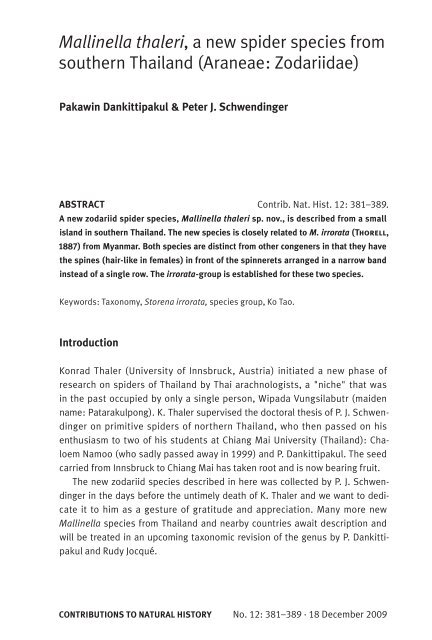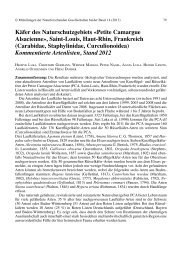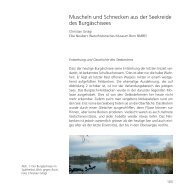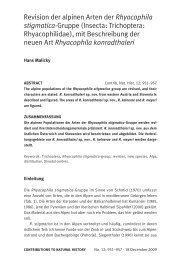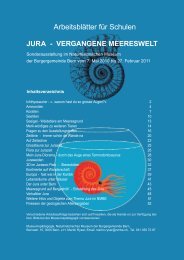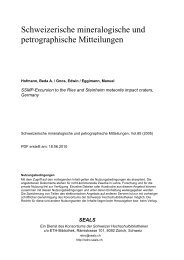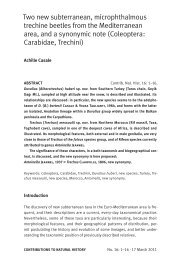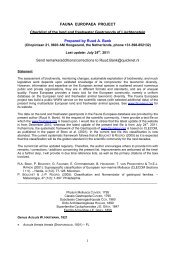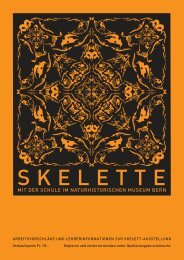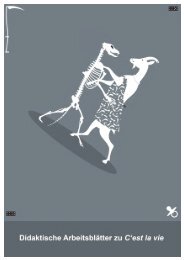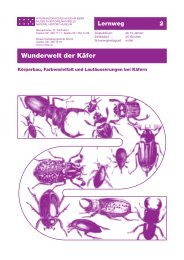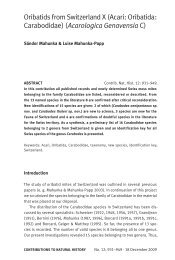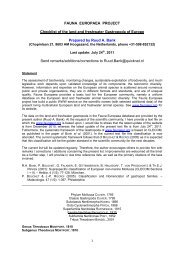Mallinella thaleri Dankittipakul & Schwendinger
Mallinella thaleri Dankittipakul & Schwendinger
Mallinella thaleri Dankittipakul & Schwendinger
Create successful ePaper yourself
Turn your PDF publications into a flip-book with our unique Google optimized e-Paper software.
<strong>Mallinella</strong> <strong>thaleri</strong>, a new spider species from<br />
southern Thailand (Araneae: Zodariidae)<br />
Pakawin <strong>Dankittipakul</strong> & Peter J. schwendinger<br />
abstraCt Contrib. Nat. Hist. 12: 381–389.<br />
a new zodariid spider species, <strong>Mallinella</strong> <strong>thaleri</strong> sp. nov., is described from a small<br />
island in southern thailand. the new species is closely related to M. irrorata (Thorell,<br />
1887) from Myanmar. both species are distinct from other congeners in that they have<br />
the spines (hair-like in females) in front of the spinnerets arranged in a narrow band<br />
instead of a single row. the irrorata-group is established for these two species.<br />
Keywords: Taxonomy, Storena irrorata, species group, Ko Tao.<br />
introduction<br />
Konrad Thaler (University of Innsbruck, Austria) initiated a new phase of<br />
research on spiders of Thailand by Thai arachnologists, a "niche" that was<br />
in the past occupied by only a single person, Wipada Vungsilabutr (maiden<br />
name: Patarakulpong). K. Thaler supervised the doctoral thesis of P. J. <strong>Schwendinger</strong><br />
on primitive spiders of northern Thailand, who then passed on his<br />
enthusiasm to two of his students at Chiang Mai University (Thailand): Chaloem<br />
Namoo (who sadly passed away in 1999) and P. <strong>Dankittipakul</strong>. The seed<br />
carried from Innsbruck to Chiang Mai has taken root and is now bearing fruit.<br />
The new zodariid species described in here was collected by P. J. <strong>Schwendinger</strong><br />
in the days before the untimely death of K. Thaler and we want to dedicate<br />
it to him as a gesture of gratitude and appreciation. Many more new<br />
<strong>Mallinella</strong> species from Thailand and nearby countries await description and<br />
will be treated in an upcoming taxonomic revision of the genus by P. <strong>Dankittipakul</strong><br />
and Rudy Jocqué.<br />
Contributions to natural History No. 12: 381–389 · 18 December 2009
Material and Methods<br />
External morphology was studied and drawn with an Olympus SZX-9 stereomicroscope<br />
equipped with a drawing tube. Photos were taken with the Auto-<br />
Montage® system using a video camera mounted on a Leica MZ APO stereomicroscope.<br />
Measurements of leg segments were taken from the dorsal side.<br />
The epigyne was drawn in natural and cleared state (immersing in lactic acid<br />
for 10–20 minutes); the male palp was drawn in lateral and ventral view. All<br />
measurements are in millimetres. The material examined will be deposited in<br />
the collections of the Muséum d'histoire naturelle de la Ville de Genève, Switzerland<br />
(MHNG) and of the Thailand Natural History Museum, National Science<br />
Museum, Pathumthani, Thailand (TNHM).<br />
Abbreviations used in the text and in the figures:<br />
ALE anterior lateral eyes<br />
AME anterior median eyes<br />
CD copulatory duct<br />
E embolus<br />
LE lateral eyes<br />
MA median apophysis<br />
ME median eyes<br />
MOQ median ocular quadrangle<br />
PER posterior eye row<br />
PLE posterior lateral eyes<br />
PME posterior median eyes<br />
RTA retrolateral tibial apophysis<br />
ST subtegulum<br />
T tegulum<br />
taxonomy<br />
Zodariidae Thorell, 1881<br />
<strong>Mallinella</strong> Strand, 1906<br />
<strong>Mallinella</strong> <strong>thaleri</strong> sp. nov. (Figs. 1–11, 13–19)<br />
Type material: Male holotype (deposited in MHNG), 5 male and 5 female paratypes<br />
(deposited in MHNG and TNHM) from southern Thailand, Surat Thani<br />
382 Pakawin <strong>Dankittipakul</strong> & Peter J. <strong>Schwendinger</strong>
Figs. 1–4. <strong>Mallinella</strong><br />
<strong>thaleri</strong> sp. nov., male<br />
holotype (1, 3) and<br />
female paratype (2, 4).<br />
Habitus, dorsal (1–2)<br />
and ventral view (3–4).<br />
Province, Ko Tao, secondary forest off the road from Ban Chalok – Ban Kao to<br />
Cape Jetakang (180 m alt.; 10° 04' 30" N, 99° 49' 26" E) and evergreen forest<br />
on top of hill east of Cape Yai Nee (330–370 m alt.; 10° 06' 58" N, 99° 49' 33"<br />
E) (mixed sample TH-05/04); leg. P. J. <strong>Schwendinger</strong>, 7.–10. VII. 2005.<br />
Etymology: The specific epithet is a patronym in memory of the late Prof.<br />
Dr. Konrad Thaler (1940–2005).<br />
Diagnosis: <strong>Mallinella</strong> <strong>thaleri</strong> sp. nov. belongs to the irrorata-group (established<br />
here), the species of which share the following somatic characteristics:<br />
Body conspicuously covered with a relatively dense pubescence (Figs. 1–8);<br />
dark chestnut-brown tegument strongly sclerotized, particularly the coarsely<br />
granulose carapace (Figs. 1–2, 5–6); spines in front of spinnerets arranged in<br />
a narrow band (Figs. 7–8) and not in a single row (sensu Jocqué 1991), these<br />
spines resembling fine elongate hairs in females (Fig. 8). The new species<br />
is similar to M. irrorata from Myanmar in having a membranous mesal subdistal<br />
flange and a baso-retrolateral ridge on the median apophysis (Figs.<br />
<strong>Mallinella</strong> <strong>thaleri</strong>, a new spider species from southern Thailand<br />
1 2<br />
3 4<br />
383
5<br />
11–12), but it can be distinguished by the posteriorly originating embolus<br />
(Fig. 9) (originating more retrolaterally in M. irrorata), by the embolus with a<br />
short branch at mid-length (Figs. 13, 15), and by the unique arrangement of<br />
white patches on the dorsal side of the opisthosoma (Figs. 1–2). In M. <strong>thaleri</strong><br />
sp. nov. the coiled part of the internal epigynal ducts is short (Figs. 17–19),<br />
whereas in M. irrorata it is more elongate and globular, with at least two coils<br />
visible in anterior view.<br />
Description: Male (holotype). Colour in alcohol: Carapace reddish brown;<br />
chelicerae, labium and sternum brown. Leg articles brown except for yellowish<br />
brown tibiae, metatarsi and tarsi. Dorsum of opisthosoma dark sepia, anteriorly<br />
with a pair of large pale patches followed by series of irregular pale stripes;<br />
venter purple, mottled with numerous irregularly arranged white spots. See<br />
Figs. 1, 3.<br />
Prosoma ovate, widest between leg coxae II and III. Carapace coarsely<br />
granular, with a fine white pubescence on pars cephalica. Legs and other<br />
sclerotized areas of body set with numerous hinged hairs on round sockets.<br />
Opisthosoma elongate oval, covered with black hairs; dorsal scutum triangular<br />
(not clearly visible in Fig. 1), relatively broad in front, with straight anterior<br />
margin, gradually tapering towards posterior end, occupying about half of<br />
opisthosoma length. Spines in front of spinnerets relatively thick and short,<br />
situated in a weakly sclerotized area (Fig. 7).<br />
Palp (Figs. 9–11, 13–15) with retrolateral tibial apophysis (RTA) broad at<br />
base, bent ectad, then turning slightly anteroventrad (visible only in ventral<br />
384 Pakawin <strong>Dankittipakul</strong> & Peter J. <strong>Schwendinger</strong><br />
6<br />
7 8<br />
Figs. 5–8. <strong>Mallinella</strong><br />
<strong>thaleri</strong> sp. nov., male<br />
holotype (5, 7) and<br />
female paratype (6, 8).<br />
Prosoma, frontal view<br />
(5–6). Posterior part of<br />
opisthosoma showing<br />
arrangement of spines<br />
in front of spinnerets,<br />
ventral view (7–8).
Figs. 9–15. left male<br />
palp of holotype of <strong>Mallinella</strong><br />
<strong>thaleri</strong> sp. nov.<br />
(9–11, 13–15) and of a<br />
<strong>Mallinella</strong> irrorata male<br />
from rangoon (12).<br />
Cymbium and tibia,<br />
ventral (9) and retrolateral<br />
view (10). Median<br />
apophysis on tegulum<br />
(11, 12). Distal part of<br />
embolus, ventral view<br />
(13). Embolic tip, prolateral<br />
view (14). Embolus<br />
at branching point,<br />
dorsal view (15).<br />
9 10<br />
c<br />
ST<br />
15<br />
14<br />
view, Fig. 10) and ending in a pointed apex. Cymbium with broad retrolateral<br />
ridge extending over approximately 3/4 of cymbium length. Median apophysis<br />
(MA) on tegulum broad at base, with a basolateral hump, terminally bending<br />
mesad. Embolic base directed posteromesad, its membranous area small, situated<br />
anteriorly. Embolus (E) relatively broad at base, with a short branch at<br />
mid-point (Figs. 13, 15).<br />
Total length 5.63. Carapace 2.86 long, 2.31 wide. Opisthosoma 3.42 long,<br />
2.56 wide. Eye sizes and interdistances: AME 0.08, ALE 0.10, PME 0.10, PLE<br />
0.11; AME-AME 0.04, AME-ALE 0.07, PME-PME 0.08, PME-PLE 0.23, ALE-PLE<br />
0.07; MOQ 0.28 long, front width 0.29, back width 0.30. Clypeus 2.50 high. Leg<br />
formula (from shortest to longest): 3214. Leg measurements, see Table 1.<br />
Female (paratype). As the male, but larger in size; anterior part of carapace<br />
relatively wider (Fig. 2, cf. Fig. 1); hinged hairs present only on coxae, trochanters,<br />
femora and patellae of legs; venter of opisthosoma with three dark purple<br />
13<br />
<strong>Mallinella</strong> <strong>thaleri</strong>, a new spider species from southern Thailand<br />
E<br />
MA<br />
T<br />
RTA<br />
11 12<br />
385
17<br />
18<br />
19<br />
bands running longitudinally between epigastric furrow and spinnerets (Fig. 4,<br />
cf. Fig. 3); spines in front of spinnerets fine, hair-like (Fig. 8, cf. Fig. 7).<br />
Epigyne and its internal structures, see Figs. 16–19. Median plate of epigyne<br />
somewhat trapezium-shaped, wider in front than behind, anterior margin<br />
slightly concave, posterior margin indistinctly convex; internal epigynal<br />
ducts moderately long, strongly sclerotized and convoluted, in lateral view<br />
bending posteriad (Fig. 18), in anterodorsal view curved ectad (Fig. 17).<br />
Total length 7.56. Carapace 3.41 long, 2.39 wide. Opisthosoma 3.82 long,<br />
2.73 wide. Eye sizes and interdistances: AME 0.10, ALE 0.12, PME 0.11, PLE<br />
0.11; AME-AME 0.05, AME-ALE 0.08, PME-PME 0.07, PME-PLE 0.25, ALE-PLE<br />
0.08; MOQ 0.30 long, front width 0.30, back width 0.32. Clypeus 2.59 high.<br />
Leg formula (from shortest to longest): 3214. Leg measurements, see Table 1.<br />
Variation: Range of measurements in males (n=6) and females (n=5; in<br />
parentheses): Body 5.10–6.21 (7.43–7.92) long, carapace 2.75–2.98 (3.29–<br />
3.75) long, 2.11–2.56 wide (2.32–2.64). There is little variation in the dorsal<br />
386 Pakawin <strong>Dankittipakul</strong> & Peter J. <strong>Schwendinger</strong><br />
16<br />
Figs. 16–19. <strong>Mallinella</strong><br />
<strong>thaleri</strong> sp. nov., female<br />
paratype. Epigyne, ventral<br />
view (16). internal<br />
structures of epigyne,<br />
anterior (17), lateral<br />
(18) and dorsolateral<br />
view (19).
and ventral pattern of the opisthosoma. The absence of some spines in front<br />
of the spinnerets is due to physical damage rather than intraspecific variation.<br />
Natural history: <strong>Mallinella</strong> <strong>thaleri</strong> sp. nov. was collected by sifting leaf litter<br />
in a secondary forest at low altitude and in a remnant patch of primary forest<br />
at the top of a hill. This species is a forest dweller, as other <strong>Mallinella</strong> species<br />
(see Jocqué 1991: 62), and seems to prefer humid and shady conditions in forests<br />
with a closed canopy.<br />
Distribution: Known only from the type locality, a small island about 64 km<br />
off the eastern coast of southern Thailand, at approximately the same latitude<br />
as the Isthmus of Kra (Kraburi).<br />
<strong>Mallinella</strong> irrorata (Thorell, 1887) (Fig. 12)<br />
<strong>Mallinella</strong> <strong>thaleri</strong>, a new spider species from southern Thailand<br />
i ii iii iV<br />
Femur 1.80 (2.51) 1.79 (2.20) 1.75 (2.21) 1.82 (2.75)<br />
Patella 0.95 (0.98) 0.91 (0.95) 0.99 (0.89) 1.02 (0.91)<br />
Tibia 1.57 (1.85) 1.31 (1.53) 1.17 (1.42) 1.78 (2.02)<br />
Metatarsus 1.95 (1.83) 1.86 (1.74) 1.89 (1.81) 2.95 (3.01)<br />
Tarsus 1.70 (1.77) 1.49 (1.53) 1.38 (1.42) 1.77 (1.83)<br />
Total 7.97 (8.94) 7.36 (7.95) 7.18 (7.75) 9.34 (10.52)<br />
tab. 1. <strong>Mallinella</strong> <strong>thaleri</strong> sp. nov.: leg measurements of male holotype and female paratype (in parentheses).<br />
Storena irrorata; Thorell (1887): 72 (description of juvenile). – Thorell (1895): 27<br />
(description of male and female). – Ono (1983): 215, fig. 9 (description of<br />
male).<br />
<strong>Mallinella</strong> irrorata: – Ono (2003): 134 (mention, new combination). – Ono (2004):<br />
3 (mention).<br />
Material examined: Juvenile holotype from Rangoon, Burma (= Myanmar), collected<br />
by L. Fea, deposited in the Museo civico di storia naturale di Genova.<br />
1 ♀ from Palon, Burma, collected by L. Fea, deposited in the Zoological Museum,<br />
University of Copenhagen. 1 ♂, 9 ♀ and 3 juveniles from Rangoon, collected<br />
by E. W. Oates, deposited in the British Museum (Natural History), London. 1<br />
♂, 2 ♀, from, Khao Kor-Hong, behind the Prince of Song Khla University Campus,<br />
Song Khla Province and District, Thailand, 15. X. 2005, collected by P.<br />
<strong>Dankittipakul</strong>, deposited in the MHNG.<br />
387
Discussion<br />
Members of the genus <strong>Mallinella</strong> are usually recognizable by the presence of<br />
a single row of small spines anterior to the spinnerets. However, this is not<br />
the case in <strong>Mallinella</strong> <strong>thaleri</strong> sp. nov. and in other species of the irroratagroup<br />
(established here), which otherwise correspond well with the current<br />
diagnosis of the genus (Strand 1906: 670, Jocqué 1991: 62). It thus is necessary<br />
to modify the present definition of the genus and focus more on genital<br />
characters. Spiders of the irrorata-group have the spines in front of the spinnerets<br />
irregularly arranged in a narrow transversal band, and in females<br />
these spines are thin and hair-like. Such a characteristic (in a more or less<br />
pronounced form) was found only in a few species from the Indo-Burmese<br />
part of the Oriental region (specimens mostly from the northern half of Thailand,<br />
some also from Myanmar and Vietnam), whereas those examined from<br />
the Sunda subregion (specimens from the Thai-Malay Peninsula and islands<br />
on the Sunda Shelf) correspond well with Jocqué's generic definition. These<br />
findings, together with descriptions of more new species in the irrorata-group,<br />
will be presented in detail in a taxonomic revision of the genus <strong>Mallinella</strong> by P.<br />
<strong>Dankittipakul</strong> and Rudy Jocqué.<br />
acknowledgements<br />
We thank Dr. Tippawan Singtripop (Chiang Mai University) and Dr. Angoon<br />
Lewvanich (Royal Academy of Thailand) for their generous support. Mrs. Janet<br />
Beccaloni (British Museum (Natural History), London), Dr. Giuliano Doria<br />
(Museo civico di storia naturale, Genova) and Dr. Nikolaj Scharff (Zoological<br />
Museum, University of Copenhagen) kindly allowed us to study specimens<br />
from these collections. We thank Dr. Hirotsugu Ono (National Science Museum,<br />
Tokyo) for providing reprints of his articles on <strong>Mallinella</strong> species from<br />
Southeast Asia. John Hollier (MHNG) checked the English text. The graduate<br />
School of Chiang Mai University supported P. <strong>Dankittipakul</strong> during his studies<br />
and the Thailand Research Fund provided a grant through the Royal Golden<br />
Jubilee Ph. D. Programm (PHD/0017/2551). The Department of National Park,<br />
Wildlife & Plant Conservation gave permission to collect spiders in protected<br />
areas.<br />
388 Pakawin <strong>Dankittipakul</strong> & Peter J. <strong>Schwendinger</strong>
eferences<br />
Jocqué, R. (1991): A generic revision of the spider family Zodariidae (Araneae). — Bulletin<br />
of the American Museum of Natural History 201: 1–160.<br />
Ono, H. (1983): Zodariidae aus dem Nepal-Himalaya. I. Neue Arten der Gattung Storena<br />
Walckenaer 1805 (Arachnida: Araneae). — Senckenbergiana biologica 63: 211–217.<br />
Ono, H. (2003): Four new species of the family Zodariidae (Arachnida, Araneae) from Vietnam.<br />
— Bulletin of the National Science Museum, Series A (Zoology) 29 (3): 131–139.<br />
Ono, H. (2004): Three new species of genus <strong>Mallinella</strong> (Araneae, Zodariidae) from Vietnam.<br />
— Bulletin of the National Science Museum, Series A (Zoology) 30 (1): 1–7.<br />
Strand, E. (1906): Diagnosen nordafrikanischer, hauptsächlich von Carlo Freiherr von Erlanger<br />
gesammelter Spinnen. — Zoologischer Anzeiger 30: 604–637, 655–690.<br />
Thorell, T. (1887): Viaggio di L. Fea in Birmania e regioni vicine. II. Primo saggio sui Ragni<br />
birmani. — Annali del Museo civico di storia naturale di Genova 25: 5–417.<br />
Thorell, T. (1895): Descriptive catalogue of the spiders of Burma. — 406 pp., British Museum,<br />
London.<br />
addresses of the authors:<br />
Pakawin <strong>Dankittipakul</strong><br />
Department of Biology<br />
Faculty of Science<br />
Chiang Mai University<br />
Chiang Mai 50200, Thailand<br />
Dr. Peter J. <strong>Schwendinger</strong> (corresponding author)<br />
Département des Arthropodes et d'Entomologie I<br />
Muséum d'histoire naturelle<br />
case postale 6434<br />
CH–1211 Genève 6, Switzerland<br />
E-mail: peter.schwendinger@ville-ge.ch<br />
<strong>Mallinella</strong> <strong>thaleri</strong>, a new spider species from southern Thailand<br />
389


